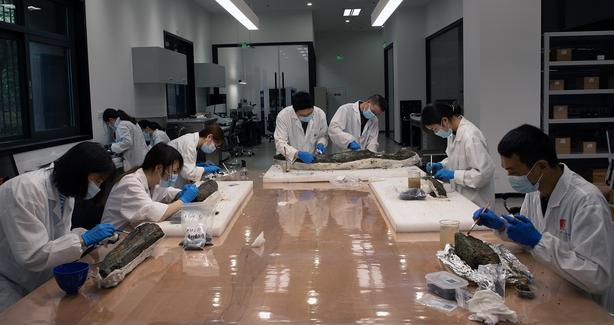 Unearthed relics are restored at the Sanxingdui Ruins site. (PHOTO PROVIDED TO CHINA DAILY)
Unearthed relics are restored at the Sanxingdui Ruins site. (PHOTO PROVIDED TO CHINA DAILY)
When people in Si-chuan province find trekking in mountainous areas difficult, they resort
to the time-honored tradition of paying to be carried in bamboo sedan chairs known locally as huagan.
Locals were amused when they saw a newly excavated artifact, part of which features four bronze human figurines carrying an altar — which residents joked was a huagan.
The figurines are part of a bronze altar dating back several thousand years that was recently excavated from the Sanxingdui Ruins in Guanghan, 40 kilometers north of Chengdu, the provincial capital.
The altar is one of nearly 13,000 cultural relics excavated from six new pits at the Sanxingdui Ruins, including bronze, gold and jade items.
The ruins, which cover 12 square km, include the remains of an ancient city, sacrificial pits, residential quarters and tombs.
Scholars believe the site was established 2,800 to 4,800 years ago, and that the archaeological discoveries show that it was a highly developed and prosperous cultural hub in ancient times.
The site was discovered accidentally in 1929, when Yan Daocheng, a villager in Guanghan, unearthed a pit full of jade and stone artifacts while repairing a sewage ditch at the side of his house.
From the 1930s onward, numerous archaeologists conducted excavations at the site. The breakthrough came in 1984, when the remains of large palaces and parts of the eastern, western and southern city walls were found at the site.
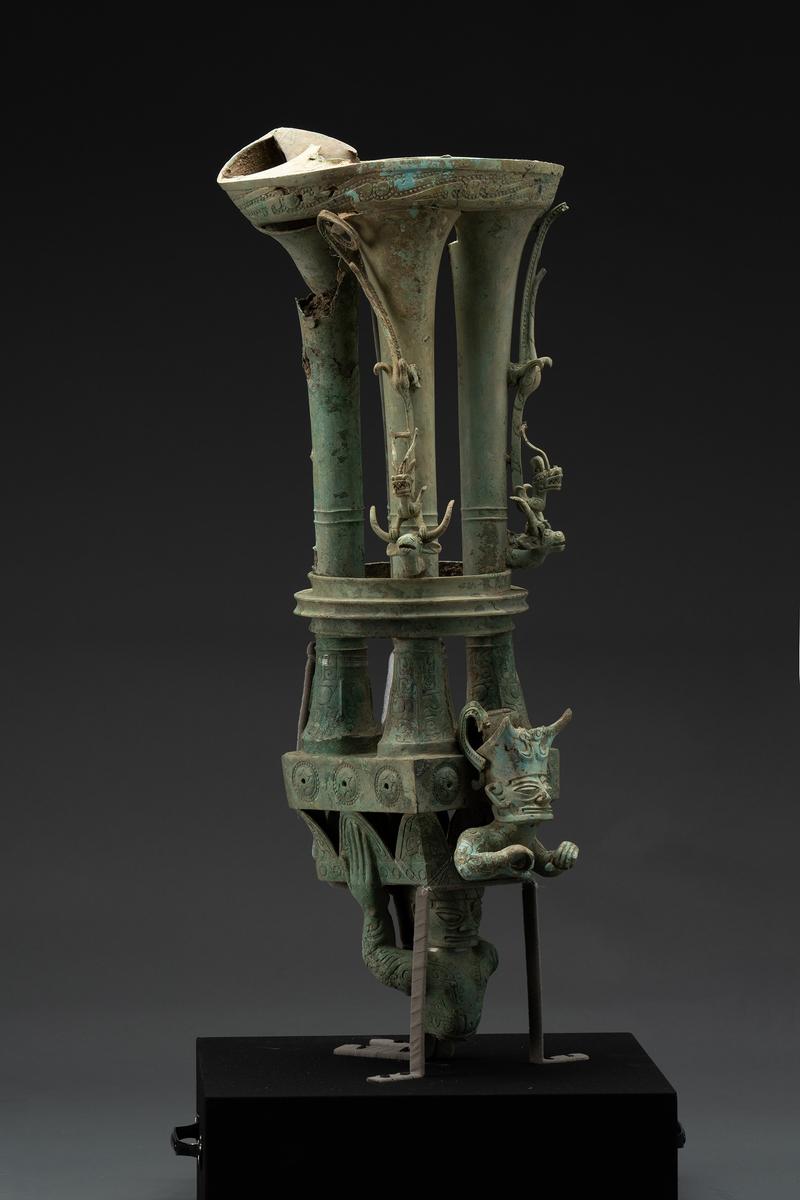 Newly discovered artifacts at the Sanxingdui Ruins include vessels resembling human figurines (pictured) from No 3 pit, a bronze altar from No 8 pit, and assorted items. (PHOTO PROVIDED TO CHINA DAILY)
Newly discovered artifacts at the Sanxingdui Ruins include vessels resembling human figurines (pictured) from No 3 pit, a bronze altar from No 8 pit, and assorted items. (PHOTO PROVIDED TO CHINA DAILY)
Two years later, two large pits full of bronze artifacts, including bizarre masks and human figurines, were found at the location.
The discoveries confirmed that the site housed the ruins of an ancient city that was the political, economic and cultural center of the Shu Kingdom. In ancient times, Sichuan was known as Shu.
The site is considered to be one of the most important archaeological discoveries in China in the 20th century.
The latest excavations cover 1,834 square meters at Sanxingdui’s six newly discovered pits, which are next to the first two.
Archaeologists have discovered artifacts that include the bronze altar, a net-like grid covering a vessel shaped like a tortoise shell, a human figurine with a serpent’s body carrying a zun — a vessel used for rituals — on its head, and a bronze artifact shaped like a dragon, with a pig’s nose.
Ran Honglin, an archaeologist at the Sichuan Provincial Cultural Relics and Archaeology Research Institute, said, “We have never seen anything like these items before at Sanxingdui.”
The six new pits were discovered by a team set up by the institute and schools such as Peking University and Sichuan University.
The bronze altar is one of the most important of the newly discovered artifacts. Three dilapidated bronze altars were excavated from the No 2 pit in 1986, but only one of these provided sufficient clues to form a vague idea of the artifact’s structure.
The altar is divided into three layers by two platforms. The bottom layer features two large, mythical birdlike animals standing next to each other, but facing in opposite directions.
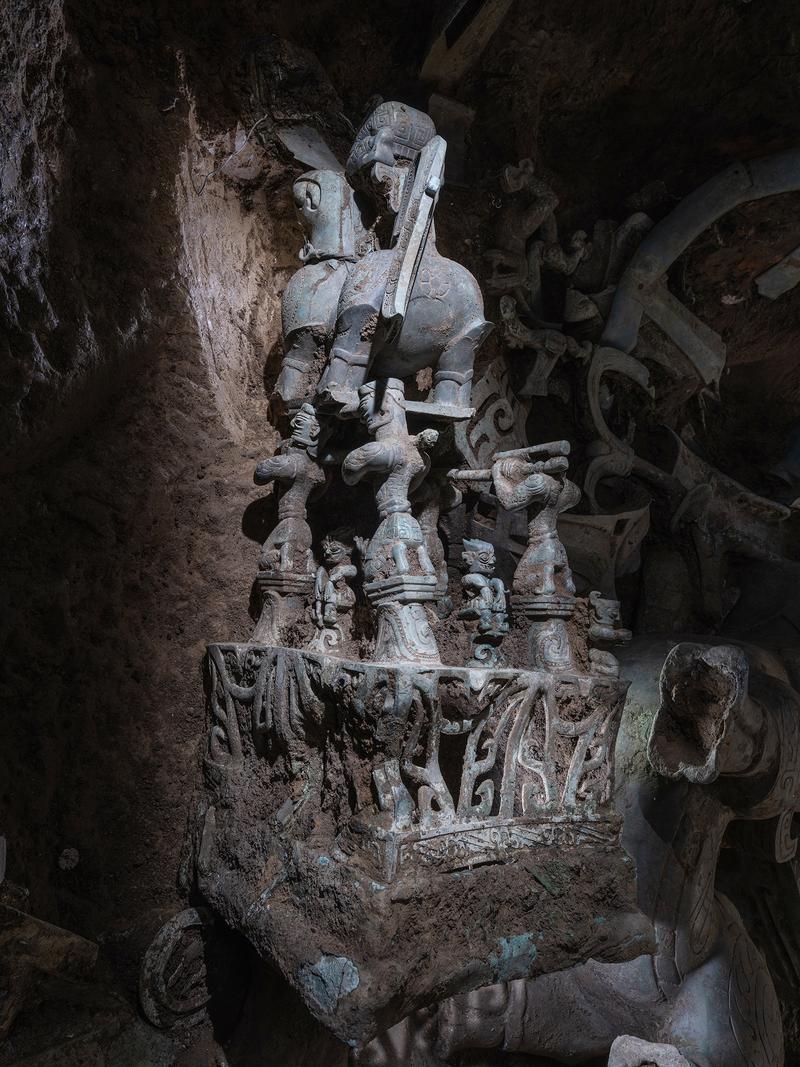 Newly discovered artifacts at the Sanxingdui Ruins include vessels resembling human figurines from No 3 pit, a bronze altar (pictured) from No 8 pit, and assorted items. (PHOTO PROVIDED TO CHINA DAILY)
Newly discovered artifacts at the Sanxingdui Ruins include vessels resembling human figurines from No 3 pit, a bronze altar (pictured) from No 8 pit, and assorted items. (PHOTO PROVIDED TO CHINA DAILY)
The middle layer boasts four human figurines, standing and facing in four directions, each with protruding eyes and wearing a tall hat. Over their heads, these figurines carry sculptures in the shape of four “mountains” connected to each other.
The top layer features a boxlike structure. Five dancing figurines are positioned on the sides of the “box”, while at each of the four corners on the top, a bird stands flapping its wings while preparing to fly.
According to researchers, the strange-looking altar was probably used for sacrifices at the Shu Kingdom’s ancestral shrine.
Researchers said the altar provides clues to religious conceptions, political tenets, architectural styles and other elements of ancient Shu culture. It is invaluable in helping explore the Shu people’s world, the inner core of primitive religion, and the system used to build ancestral temples in the area.
Carbon dating on nearly 200 relics from the six new pits at the Sanxingdui site show that these date from 1131 to 1012 BC during the late period of the Shang Dynasty (16th to 11th centuries BC).
Lei Xingshan, a professor of history at Capital Normal University in Beijing, said the age of the pits was disputed for more than three decades, and carbon dating was not used in earlier excavations because not enough relics were available for the purpose.
Archaeologists believe that all eight pits were used for sacrificial purposes. As many of the artifacts from No 1 and No 2 pits displayed at the Sanxingdui Museum resemble bronze human faces with protruding eyes, there has been speculation that they are the work of aliens.
Numerous discoveries made during the latest excavations at the six pits show that the ancient Shu Kingdom was an important part of Chinese civilization.
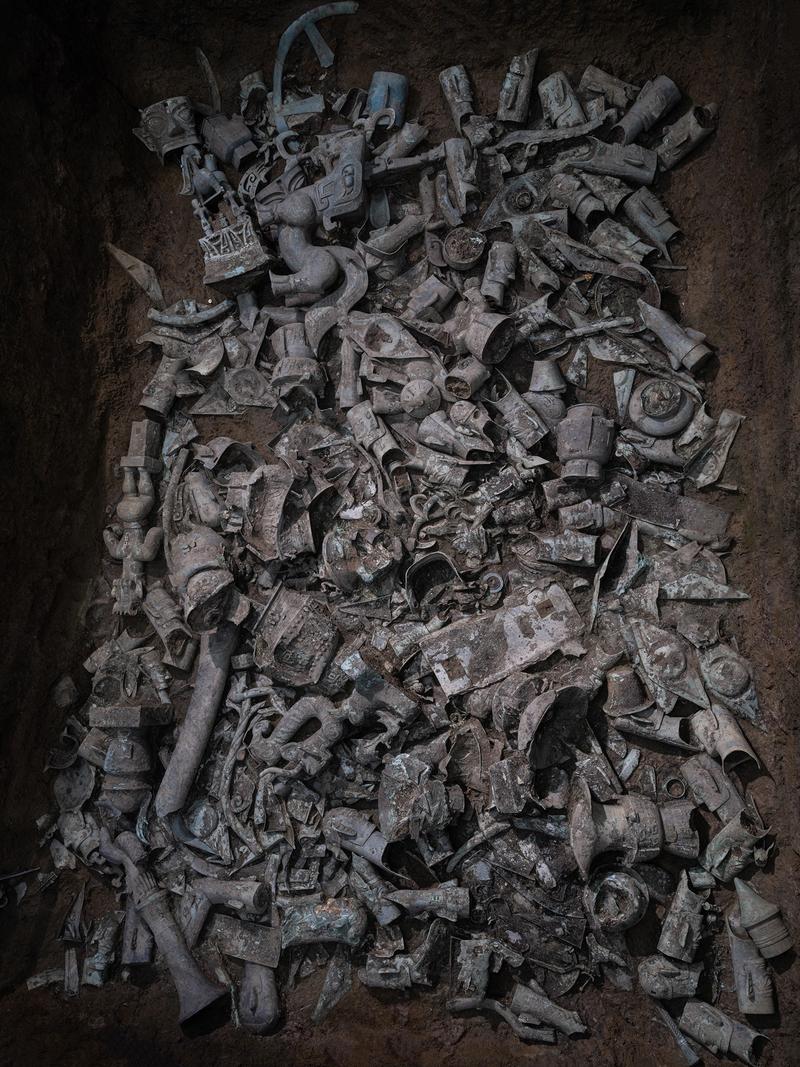 Newly discovered artifacts at the Sanxingdui Ruins include vessels resembling human figurines from No 3 pit, a bronze altar from No 8 pit, and assorted items (pictured). (PHOTO PROVIDED TO CHINA DAILY)
Newly discovered artifacts at the Sanxingdui Ruins include vessels resembling human figurines from No 3 pit, a bronze altar from No 8 pit, and assorted items (pictured). (PHOTO PROVIDED TO CHINA DAILY)
A number of recently excavated artifacts suggest a close cultural connection between the Sanxingdui site and other parts of the country.
For example, a copper zun and urns found in No 3 and No 8 pits are typical Shang Dynasty bronze artifacts from the central plains.
Jade tablets and circular jade artifacts known as bi found in No 7 and No 8 pits have also been discovered in Henan, Shaanxi and Shandong provinces, and other areas of the country.
On the newly excavated altar’s platform, which boasts 13 bronze human figurines, a small figurine carries a lei, a bronze container used during sacrifices.
Wang Wei, president of the Archaeological Society of China, thinks that carbon dating of some 200 relics excavated from the six new pits explains the relationship between the Sanxingdui Ruins and the Jinsha Ruins in Chengdu.
He said the Jinsha site, which is 2,700 to 3,000 years old, was another important part of the ancient Shu civilization.
When Sanxingdui declined, Jinsha rose, and the relationship between the two is greatly significant for studying ancient Shu civilization, Wang added.
Zhu Zhangyi, curator of the Jinsha Site Museum in Chengdu, said the ruins at Sanxingdui and Jinsha are closely related.
The Jinsha Ruins are likely to have been the political and cultural center of the Shu Kingdom, which moved from Sanxingdui about 3,000 years ago, said Zhu, who has been an archaeologist since taking part in the excavation of the No 1 and No 2 pits at the Sanxingdui Ruins in 1986.
Occupying 5 sq km, the Jinsha Ruins, home to the Jinsha Site Museum, include an area for holding sacrificial rites, residential quarters for the nobility, a residential complex for commoners, and a graveyard.
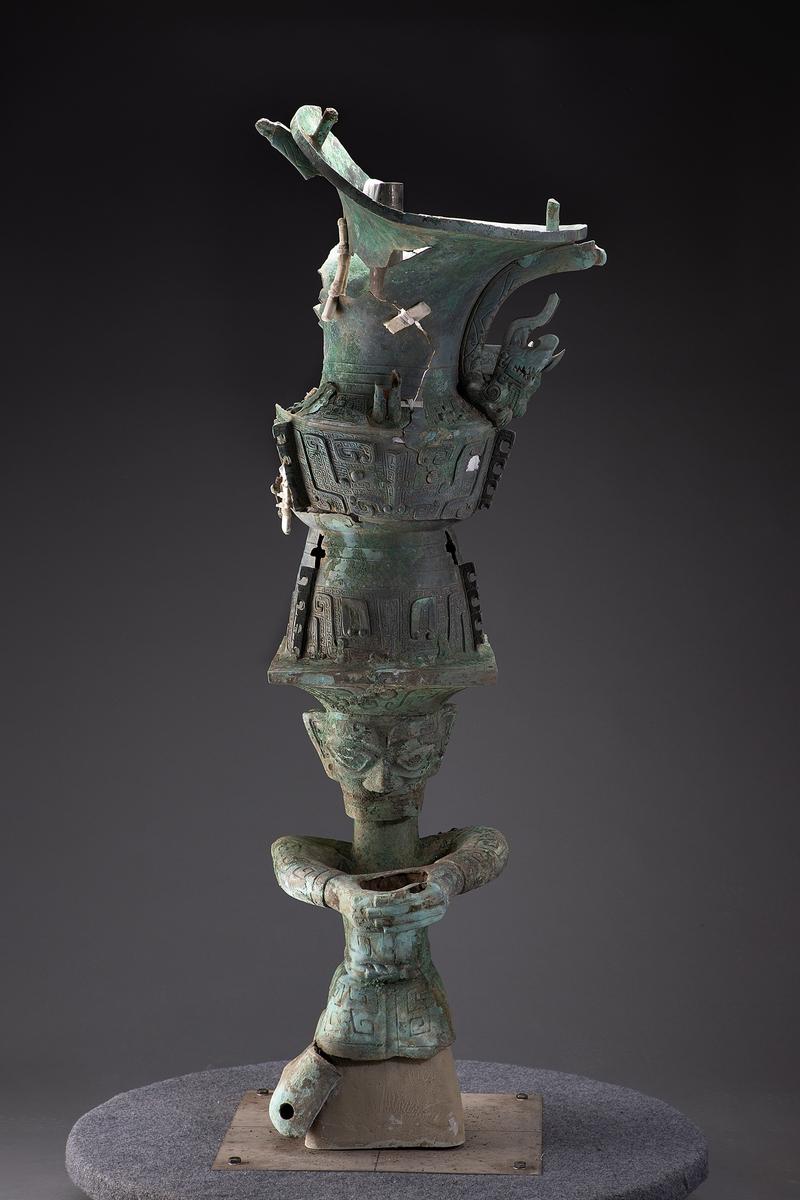 Newly discovered artifacts at the Sanxingdui Ruins include vessels resembling human figurines (pictured) from No 3 pit, a bronze altar from No 8 pit, and assorted items. (PHOTO PROVIDED TO CHINA DAILY)
Newly discovered artifacts at the Sanxingdui Ruins include vessels resembling human figurines (pictured) from No 3 pit, a bronze altar from No 8 pit, and assorted items. (PHOTO PROVIDED TO CHINA DAILY)
According to experts, these ruins are one of the most important archaeological findings since the discovery of the Sanxingdui site.
On Feb 8, 2001, builders working on an apartment construction site in Jinsha village found ivory and jade pieces in the earth.
Archaeologists have since excavated more than 10,000 precious relics, including gold, jade, bronze and stone items, as well as 1 metric ton of intact elephant tusks and tens of thousands of pottery and ceramic shards.
Zhu said Jinsha is known as one of China’s most prolific excavations for gold and jade artifacts. It is also home to one of the world’s largest excavations of ancient elephant tusks.
Archaeologists who comprehensively analyzed the relics from San-xingdui and Jinsha, including gold, bronze, jade, stone, ivory and pottery items, discovered similarities in type, shape and processing techniques.
A 14.6-centimeter-high bronze figure unearthed at the Jinsha Ruins is on display at the Jinsha Site Museum. The figure is similar to the 180-cm standing bronze figure found in the No 2 pit at the Sanxingdui Ruins.
The head of a jade godlike sculpture placed in an obscure corner of the No 3 exhibition hall at the Jinsha Site Museum appears to be similar to an item unearthed at the Sanxingdui Ruins.
This ferocious-looking jade object, which is 2.3 cm high and 3.4 cm wide, sports a decorative hat, has a long eyebrow, a triangular eye, a crooked nose and a large mouth revealing three teeth. The lower end of the object is broken.
Like the Sanxingdui Museum, whose exhibits come mainly from the sacrificial pits at the Sanxingdui Ruins, most items at the Jinsha Site Museum are from an area used for holding sacrificial rites.
According to Zhu Yarong, deputy curator of the Sanxingdui Museum, 18,000 relics have been unearthed from the eight pits at the Sanxingdui Ruins. Many important discoveries made at the first two pits in 1986 are on display at the museum.


